Quan Vuong
Hi Robot: Open-Ended Instruction Following with Hierarchical Vision-Language-Action Models
Feb 26, 2025Abstract:Generalist robots that can perform a range of different tasks in open-world settings must be able to not only reason about the steps needed to accomplish their goals, but also process complex instructions, prompts, and even feedback during task execution. Intricate instructions (e.g., "Could you make me a vegetarian sandwich?" or "I don't like that one") require not just the ability to physically perform the individual steps, but the ability to situate complex commands and feedback in the physical world. In this work, we describe a system that uses vision-language models in a hierarchical structure, first reasoning over complex prompts and user feedback to deduce the most appropriate next step to fulfill the task, and then performing that step with low-level actions. In contrast to direct instruction following methods that can fulfill simple commands ("pick up the cup"), our system can reason through complex prompts and incorporate situated feedback during task execution ("that's not trash"). We evaluate our system across three robotic platforms, including single-arm, dual-arm, and dual-arm mobile robots, demonstrating its ability to handle tasks such as cleaning messy tables, making sandwiches, and grocery shopping.
FAST: Efficient Action Tokenization for Vision-Language-Action Models
Jan 16, 2025Abstract:Autoregressive sequence models, such as Transformer-based vision-language action (VLA) policies, can be tremendously effective for capturing complex and generalizable robotic behaviors. However, such models require us to choose a tokenization of our continuous action signals, which determines how the discrete symbols predicted by the model map to continuous robot actions. We find that current approaches for robot action tokenization, based on simple per-dimension, per-timestep binning schemes, typically perform poorly when learning dexterous skills from high-frequency robot data. To address this challenge, we propose a new compression-based tokenization scheme for robot actions, based on the discrete cosine transform. Our tokenization approach, Frequency-space Action Sequence Tokenization (FAST), enables us to train autoregressive VLAs for highly dexterous and high-frequency tasks where standard discretization methods fail completely. Based on FAST, we release FAST+, a universal robot action tokenizer, trained on 1M real robot action trajectories. It can be used as a black-box tokenizer for a wide range of robot action sequences, with diverse action spaces and control frequencies. Finally, we show that, when combined with the pi0 VLA, our method can scale to training on 10k hours of robot data and match the performance of diffusion VLAs, while reducing training time by up to 5x.
What's the Move? Hybrid Imitation Learning via Salient Points
Dec 06, 2024



Abstract:While imitation learning (IL) offers a promising framework for teaching robots various behaviors, learning complex tasks remains challenging. Existing IL policies struggle to generalize effectively across visual and spatial variations even for simple tasks. In this work, we introduce SPHINX: Salient Point-based Hybrid ImitatioN and eXecution, a flexible IL policy that leverages multimodal observations (point clouds and wrist images), along with a hybrid action space of low-frequency, sparse waypoints and high-frequency, dense end effector movements. Given 3D point cloud observations, SPHINX learns to infer task-relevant points within a point cloud, or salient points, which support spatial generalization by focusing on semantically meaningful features. These salient points serve as anchor points to predict waypoints for long-range movement, such as reaching target poses in free-space. Once near a salient point, SPHINX learns to switch to predicting dense end-effector movements given close-up wrist images for precise phases of a task. By exploiting the strengths of different input modalities and action representations for different manipulation phases, SPHINX tackles complex tasks in a sample-efficient, generalizable manner. Our method achieves 86.7% success across 4 real-world and 2 simulated tasks, outperforming the next best state-of-the-art IL baseline by 41.1% on average across 440 real world trials. SPHINX additionally generalizes to novel viewpoints, visual distractors, spatial arrangements, and execution speeds with a 1.7x speedup over the most competitive baseline. Our website (http://sphinx-manip.github.io) provides open-sourced code for data collection, training, and evaluation, along with supplementary videos.
$π_0$: A Vision-Language-Action Flow Model for General Robot Control
Oct 31, 2024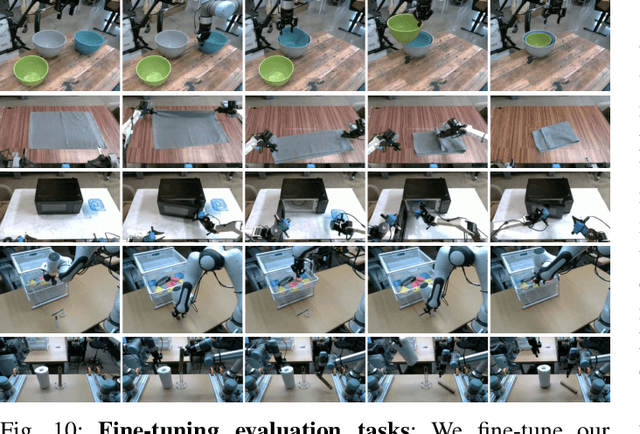
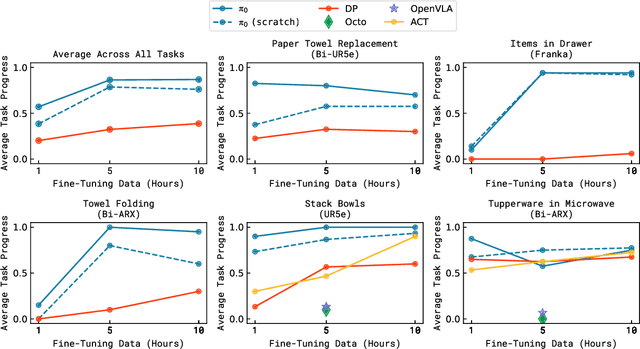
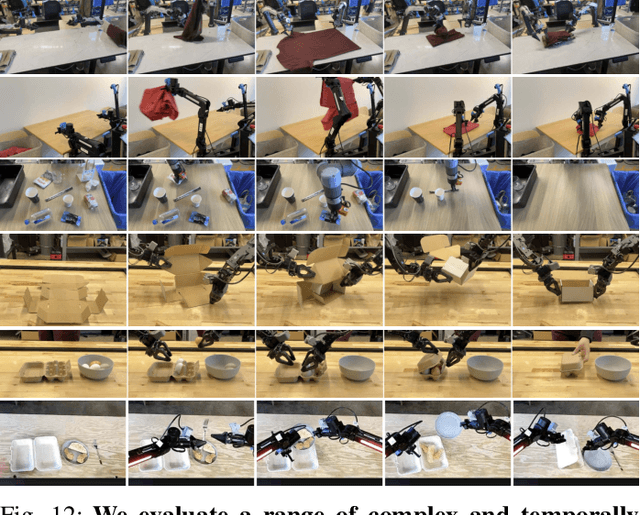
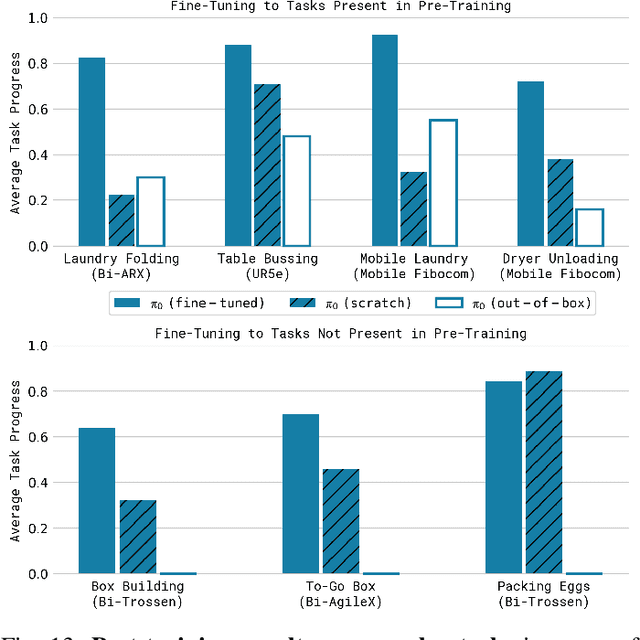
Abstract:Robot learning holds tremendous promise to unlock the full potential of flexible, general, and dexterous robot systems, as well as to address some of the deepest questions in artificial intelligence. However, bringing robot learning to the level of generality required for effective real-world systems faces major obstacles in terms of data, generalization, and robustness. In this paper, we discuss how generalist robot policies (i.e., robot foundation models) can address these challenges, and how we can design effective generalist robot policies for complex and highly dexterous tasks. We propose a novel flow matching architecture built on top of a pre-trained vision-language model (VLM) to inherit Internet-scale semantic knowledge. We then discuss how this model can be trained on a large and diverse dataset from multiple dexterous robot platforms, including single-arm robots, dual-arm robots, and mobile manipulators. We evaluate our model in terms of its ability to perform tasks in zero shot after pre-training, follow language instructions from people and from a high-level VLM policy, and its ability to acquire new skills via fine-tuning. Our results cover a wide variety of tasks, such as laundry folding, table cleaning, and assembling boxes.
RoVi-Aug: Robot and Viewpoint Augmentation for Cross-Embodiment Robot Learning
Sep 05, 2024



Abstract:Scaling up robot learning requires large and diverse datasets, and how to efficiently reuse collected data and transfer policies to new embodiments remains an open question. Emerging research such as the Open-X Embodiment (OXE) project has shown promise in leveraging skills by combining datasets including different robots. However, imbalances in the distribution of robot types and camera angles in many datasets make policies prone to overfit. To mitigate this issue, we propose RoVi-Aug, which leverages state-of-the-art image-to-image generative models to augment robot data by synthesizing demonstrations with different robots and camera views. Through extensive physical experiments, we show that, by training on robot- and viewpoint-augmented data, RoVi-Aug can zero-shot deploy on an unseen robot with significantly different camera angles. Compared to test-time adaptation algorithms such as Mirage, RoVi-Aug requires no extra processing at test time, does not assume known camera angles, and allows policy fine-tuning. Moreover, by co-training on both the original and augmented robot datasets, RoVi-Aug can learn multi-robot and multi-task policies, enabling more efficient transfer between robots and skills and improving success rates by up to 30%.
Language-Driven 6-DoF Grasp Detection Using Negative Prompt Guidance
Jul 18, 2024



Abstract:6-DoF grasp detection has been a fundamental and challenging problem in robotic vision. While previous works have focused on ensuring grasp stability, they often do not consider human intention conveyed through natural language, hindering effective collaboration between robots and users in complex 3D environments. In this paper, we present a new approach for language-driven 6-DoF grasp detection in cluttered point clouds. We first introduce Grasp-Anything-6D, a large-scale dataset for the language-driven 6-DoF grasp detection task with 1M point cloud scenes and more than 200M language-associated 3D grasp poses. We further introduce a novel diffusion model that incorporates a new negative prompt guidance learning strategy. The proposed negative prompt strategy directs the detection process toward the desired object while steering away from unwanted ones given the language input. Our method enables an end-to-end framework where humans can command the robot to grasp desired objects in a cluttered scene using natural language. Intensive experimental results show the effectiveness of our method in both benchmarking experiments and real-world scenarios, surpassing other baselines. In addition, we demonstrate the practicality of our approach in real-world robotic applications. Our project is available at https://airvlab.github.io/grasp-anything.
OpenVLA: An Open-Source Vision-Language-Action Model
Jun 13, 2024
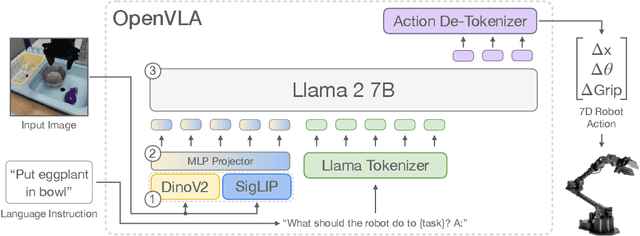
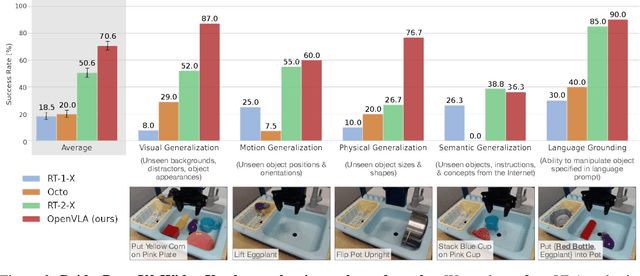
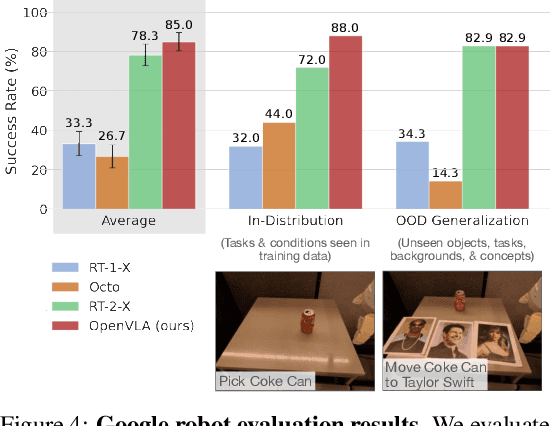
Abstract:Large policies pretrained on a combination of Internet-scale vision-language data and diverse robot demonstrations have the potential to change how we teach robots new skills: rather than training new behaviors from scratch, we can fine-tune such vision-language-action (VLA) models to obtain robust, generalizable policies for visuomotor control. Yet, widespread adoption of VLAs for robotics has been challenging as 1) existing VLAs are largely closed and inaccessible to the public, and 2) prior work fails to explore methods for efficiently fine-tuning VLAs for new tasks, a key component for adoption. Addressing these challenges, we introduce OpenVLA, a 7B-parameter open-source VLA trained on a diverse collection of 970k real-world robot demonstrations. OpenVLA builds on a Llama 2 language model combined with a visual encoder that fuses pretrained features from DINOv2 and SigLIP. As a product of the added data diversity and new model components, OpenVLA demonstrates strong results for generalist manipulation, outperforming closed models such as RT-2-X (55B) by 16.5% in absolute task success rate across 29 tasks and multiple robot embodiments, with 7x fewer parameters. We further show that we can effectively fine-tune OpenVLA for new settings, with especially strong generalization results in multi-task environments involving multiple objects and strong language grounding abilities, and outperform expressive from-scratch imitation learning methods such as Diffusion Policy by 20.4%. We also explore compute efficiency; as a separate contribution, we show that OpenVLA can be fine-tuned on consumer GPUs via modern low-rank adaptation methods and served efficiently via quantization without a hit to downstream success rate. Finally, we release model checkpoints, fine-tuning notebooks, and our PyTorch codebase with built-in support for training VLAs at scale on Open X-Embodiment datasets.
Octo: An Open-Source Generalist Robot Policy
May 20, 2024



Abstract:Large policies pretrained on diverse robot datasets have the potential to transform robotic learning: instead of training new policies from scratch, such generalist robot policies may be finetuned with only a little in-domain data, yet generalize broadly. However, to be widely applicable across a range of robotic learning scenarios, environments, and tasks, such policies need to handle diverse sensors and action spaces, accommodate a variety of commonly used robotic platforms, and finetune readily and efficiently to new domains. In this work, we aim to lay the groundwork for developing open-source, widely applicable, generalist policies for robotic manipulation. As a first step, we introduce Octo, a large transformer-based policy trained on 800k trajectories from the Open X-Embodiment dataset, the largest robot manipulation dataset to date. It can be instructed via language commands or goal images and can be effectively finetuned to robot setups with new sensory inputs and action spaces within a few hours on standard consumer GPUs. In experiments across 9 robotic platforms, we demonstrate that Octo serves as a versatile policy initialization that can be effectively finetuned to new observation and action spaces. We also perform detailed ablations of design decisions for the Octo model, from architecture to training data, to guide future research on building generalist robot models.
Evaluating Real-World Robot Manipulation Policies in Simulation
May 09, 2024



Abstract:The field of robotics has made significant advances towards generalist robot manipulation policies. However, real-world evaluation of such policies is not scalable and faces reproducibility challenges, which are likely to worsen as policies broaden the spectrum of tasks they can perform. We identify control and visual disparities between real and simulated environments as key challenges for reliable simulated evaluation and propose approaches for mitigating these gaps without needing to craft full-fidelity digital twins of real-world environments. We then employ these approaches to create SIMPLER, a collection of simulated environments for manipulation policy evaluation on common real robot setups. Through paired sim-and-real evaluations of manipulation policies, we demonstrate strong correlation between policy performance in SIMPLER environments and in the real world. Additionally, we find that SIMPLER evaluations accurately reflect real-world policy behavior modes such as sensitivity to various distribution shifts. We open-source all SIMPLER environments along with our workflow for creating new environments at https://simpler-env.github.io to facilitate research on general-purpose manipulation policies and simulated evaluation frameworks.
Vid2Robot: End-to-end Video-conditioned Policy Learning with Cross-Attention Transformers
Mar 19, 2024



Abstract:While large-scale robotic systems typically rely on textual instructions for tasks, this work explores a different approach: can robots infer the task directly from observing humans? This shift necessitates the robot's ability to decode human intent and translate it into executable actions within its physical constraints and environment. We introduce Vid2Robot, a novel end-to-end video-based learning framework for robots. Given a video demonstration of a manipulation task and current visual observations, Vid2Robot directly produces robot actions. This is achieved through a unified representation model trained on a large dataset of human video and robot trajectory. The model leverages cross-attention mechanisms to fuse prompt video features to the robot's current state and generate appropriate actions that mimic the observed task. To further improve policy performance, we propose auxiliary contrastive losses that enhance the alignment between human and robot video representations. We evaluate Vid2Robot on real-world robots, demonstrating a 20% improvement in performance compared to other video-conditioned policies when using human demonstration videos. Additionally, our model exhibits emergent capabilities, such as successfully transferring observed motions from one object to another, and long-horizon composition, thus showcasing its potential for real-world applications. Project website: vid2robot.github.io
 Add to Chrome
Add to Chrome Add to Firefox
Add to Firefox Add to Edge
Add to Edge